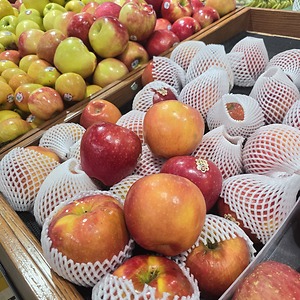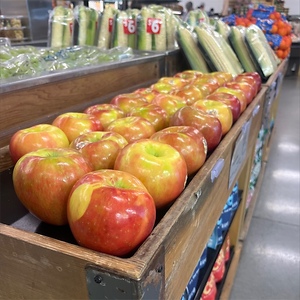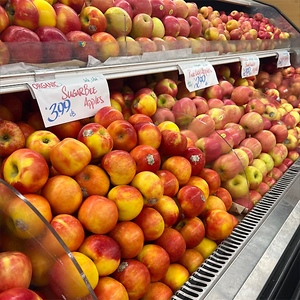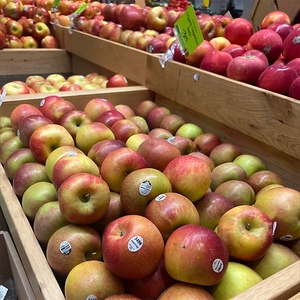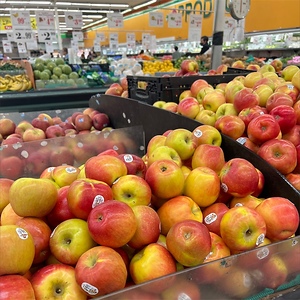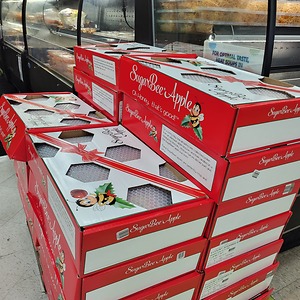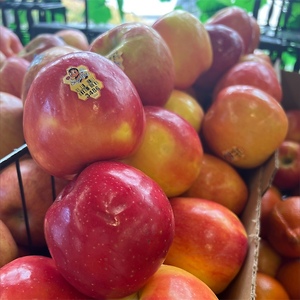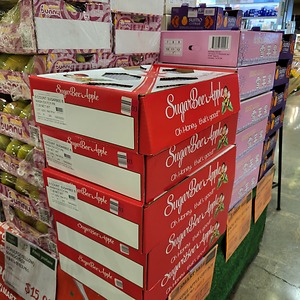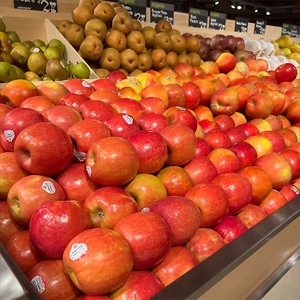

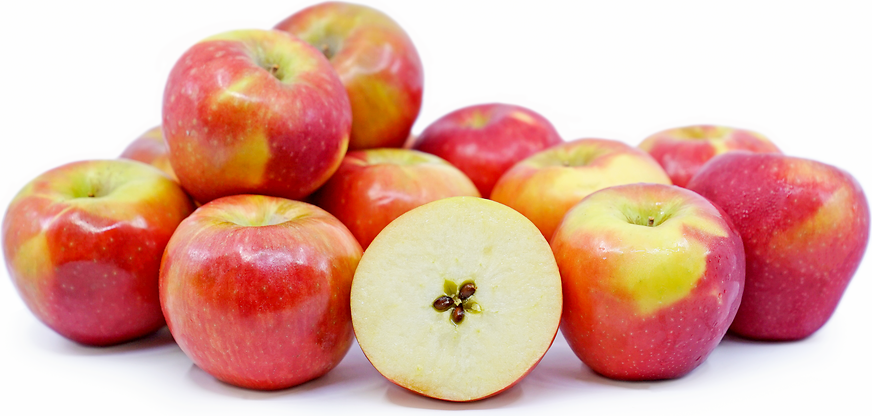
SugarBee® Apples
Estimated Inventory, 24 ct : 0
Description/Taste
SugarBee® apples are a medium to large varietal, averaging 7 to 9 centimeters in diameter, and have a round to conical, tapered shape with a slightly lopsided nature. The apple’s skin is semi-thin, tough, and glossy, showcasing light brown russet in the stem cavity and a faint bloom covering the surface. The skin also has a yellow-green base, enveloped in a bright red wash with a few dark red stripes and prominent tan lenticels. Underneath the surface, the white flesh is coarse, aqueous, and crunchy with a crisp, cracking consistency. The flesh also encases a small central fibrous core filled with dark brown, oval seeds. SugarBee® apples emit a sweet aroma and have high sugar content, generally reaching 14.6 Brix, compared to their parent variety honeycrisp, that reaches 13.8 Brix. The apples have a mild, sweet, and subacid flavor with fruity undertones enhanced with caramel and floral nuances.
Seasons/Availability
SugarBee® apples are harvested in the fall and can be stored through the winter.
Current Facts
SugarBee® apples, botanically classified as Malus domestica, are a bi-colored American variety belonging to the Rosaceae family. The modern apple cultivar was discovered in the late 20th century as a chance seedling in an orchard in Minnesota and was selected for its sweet flavor, crisp nature, and brightly colored skin. SugarBee® apples were named in honor of their open cross-pollinated heritage, pollinated by bees, and their sweet flavor reminiscent of their parent variety, honeycrisp. The proprietary variety is managed by the Chelan Fresh Growing Group and ripens approximately ten days after honeycrisp apples. Apple enthusiasts value SugarBee® apples as an improved honeycrisp-like variety. The apples are considered sweeter than honeycrisp, showcase more solid washes of red blush, and exhibit longer storage capabilities without losing flavor or going flat.
Nutritional Value
SugarBee® apples are a source of vitamin C to strengthen the immune system while reducing inflammation and fiber to regulate the digestive tract. The apples also provide potassium to balance fluid levels within the body, vitamin A to maintain healthy organ functioning, calcium and phosphorus to protect bones and teeth, and other nutrients, including iron, vitamin E, magnesium, boron, zinc, copper, and vitamin K.
Applications
SugarBee® apples have a mild, sweet flavor and crisp consistency well suited for fresh and cooked preparations. The apples are classified as a dessert apple, favored for eating straight, out of hand. SugarBee® apples can also be quartered and served on charcuterie plates with sharp cheeses, sliced and topped with thinly sliced meats as a crostini, layered into sandwiches, or chopped for salads, slaws, and grain bowls. The apple’s sweet taste can be used to flavor syrups, caramel, or barbeque sauce, or the flesh can be diced and scattered as a fresh topping over French toast, pancakes, and oatmeal. In addition to raw preparations, SugarBee® apples are popularly baked into coffee cake, donuts, galettes, tarts, and pies, hollowed and stuffed with nuts and dried fruits, or prepared hasselback, baked with butter, warm spices, and sugar, topped with crumble. The crisp apple also complements savory culinary dishes, chopped into stuffing, simmered into butternut squash soup, fried into fritters, baked into potato pancakes, or sauteed with Brussels sprouts as a side dish to roasted meats. Try thinly slicing SugarBee® apples as a crunchy topping over flatbread or pressing into juice for ciders, smoothies, and other beverages. SugarBee® apples pair well with cheeses such as cheddar, gouda, pimento, blue, and brie, celery, carrots, root vegetables, green beans, spices including cinnamon, allspice, nutmeg, and cloves, honey, maple syrup, vanilla, roasted meats such as pork, turkey, and poultry, and nuts including walnuts, pecans, pistachios, and almonds. Whole, unwashed SugarBee® apples will keep for several weeks to months when stored in the refrigerator's crisper drawer. In professional cold storage, the apples will keep up to five months.
Ethnic/Cultural Info
Chuck Nystrom, the breeder of SugarBee® apples, has been growing apples his entire life. His grandfather owned an apple orchard in Worthington, Minnesota, and Nystrom recalls spending most of his childhood days helping on the farm. Nystrom’s father continued in the apple business, opening his own orchard on a nearby property, and Nystrom joined his father after graduating college to pursue a career in apple breeding. When Chuck took over the farm full time after his father’s passing in 1982, he decided to join the North American Fruit Explorers, an organization that helped encourage him to try breeding new apple varieties. Approximately 15% of Nystrom’s 35-acre farm is dedicated to apple breeding, and in any given year, the farm can have 5,000 to 7,000 apple trees. Apple breeding has historically been a challenging field as the University of Minnesota has recorded that it takes around 20,000 apple tree seedlings to find one marketable variety. Nystrom listened to the advice of members in the North American Fruit Explorers and began to plant a wide array of apple seeds. Nystrom acquired apple seeds from abandoned homesteads, alongside road ditches, growing in backyards, and from friends and family. He also planted 300 honeycrisp trees in 1994 to crossbreed with the unknown apple varieties. Nystrom’s hard work paid off, a victorious achievement for a small family-owned orchard, eventually developing SugarBee® apples as his first commercial cultivar. It is rumored that he also has three other new patented apple varieties and a fourth cultivar that companies are testing for commercial release.
Geography/History
SugarBee® apples were discovered growing in Ocheda Orchard, an orchard owned by Chuck Nystrom in Worthington, Minnesota, in 1994. Nystrom experimented with growing new varieties of apples and allowed honeycrisp trees to be open-pollinated by bees and other pollinators. A unique chance seedling was noticed in 2004 that produced crisp, sweet, and colorful apples. Nystrom named the variety B-51, later CN-121, and partnered with Regal Fruit International to propagate the variety. The rights for cultivating the fruits were given to the Chelan Fresh Growing Group in Washington State. Budwood from the seedling was sent to Ephrata, Washington, and was planted on M26 rootstock in 2007 at Gebbers Farms. SugarBee® apples were submitted for a plant patent in 2011 and were granted the patent in 2013. The managed variety was slowly released to commercial markets between 2013 and 2018 with the goal of increasing production each year. Today SugarBee® apples are cultivated and marketed through Chelan Fresh and are sold through partners of the growing group, including select grocers, supermarkets, and distributors.
Recipe Ideas
Recipes that include SugarBee® Apples. One



